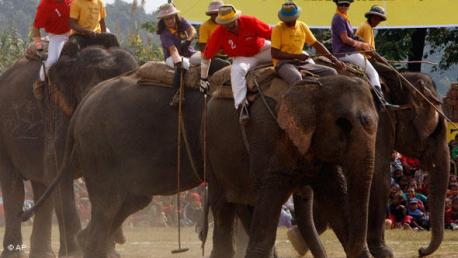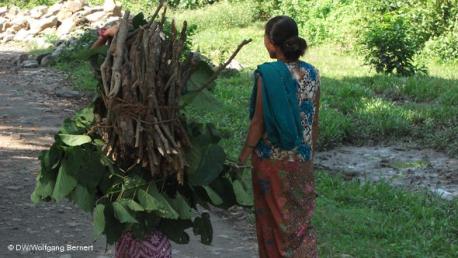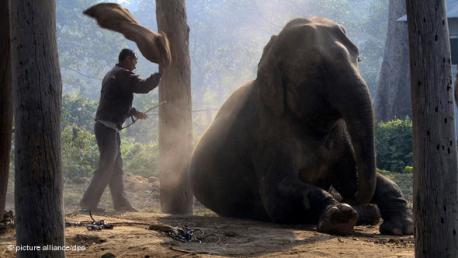Wild Weed Threat to CNP and Rhino Habitat
A wild weed, Mikania Micrantha, is posing a serious threat to unique eco system and biodiversity of Chitwan National Park (CNP), which is included in the World Natural heritage site by UNESCO.
This was revealed during the launching, by Minister for forest and soil conservation Deepak Bohara, of a 30min documentary made by Chanda Rana, Executive chairperson of Save the Environment Foundation, entitled 'Mile-a-Minute: A Serious Threat to Chitwan National Park (CNP)' today. The documentary is first of its kind produced and shown to ministry of forest and concerned authorities
The documentary highlights severity caused by Mikania risking the whole ecosystem of CNP, endangering the very survival of the entire floral and faunal community. Rana has tried to highlight the origin and nature of Mikania and source of infestation along with urgent need to make it aware to concerned authorities through her documentary.
Highlighting the contents of the documentary, Rana said she has strongly emphasized the 'potential threat to rhino habitat' by wild colonization of the notorious weed which she noticed during her visit there and shared the information with Zoological Society of London (ZSL) and National Trust for Nature Conversation (NTNC). She said, "I have presented the survey carried out in 2008 by ZSL for rhino census along with Mikenia infestation in the documentary which clearly indicates about 50% of rhino range is already affected by Mikania. At primary rhino habitat (riverine forests and tall grasses), approximately 75% of the rhinos were found to be most affected."
Additionally, the notorious weed is gradually spreading out towards the buffer zone area.
The documentary includes interviews from various experts on the issue from NTNC, Nepal Army buffer zone chief, chief warden at Chitwan, resort owners and local people.
The documentary also highlights recommendations for elimination of the wild weed. Conducting detailed study of infestation, public awareness campaigns, interaction program among concerned stakeholders, developing educational materials on ecological damages and loss caused by the weed and developing long-term projects with viable control measures and ways for complete elimination of this climber vine are some of the recommendations.
Speaking after watching the documentary, Minister Bohara said his ministry's attention has been drawn towards the devastation caused by the weed, and that the government would initiate measures and work in partnership with SEF and other such organisations to tackle the menance.
In conclusion Rana said the documentary is going to be screened at London where the ZSL is organizing an event on 24th November 2009 to mark 'Nepal Nature Conservation Year 2009'. (click to view documentary)
Invasion of CNP by Mikania Micrantha
Scientific name: Mikania Micrantha H. B. Kunth
Also known as American rope, bittervine, Chinese creeper, climbing hempweed, mikania vine, mile-a-minute, etc.
Extremely fast growing, sprawling, perennial vine-world's most notorious invaders.
Rapidly colonizes disturbed habitats, retards growth of crops/natural vegetation.
Native of tropical south and central America. Found in Mauritus, India, Sri Lanka, Bangladesh, Southeast Asia, and the Pacific.
Extent of spread and damage caused
Expanding at a very alarming rate.
Its present infestation is estimated to be over 20% of the entire national park.
The invasion is showing severely damaging effects on young trees, shrubs, grasses in mostly mixed and riverine forests and grass lands.
It smothers shrubs and small trees which are important source of food and bedding for most of wild animals in the park.
Gradually spreading out towards buffer zone area. If unchecked, could threaten the livelihoods of the local people in buffer zone.
Dispersed by wind, animals and by natural process.
-Risking the whole ecosystem of the CNP endangering the very survival of entire floral and faunal community.
Details of Chitwan National park
Established in 1973
CNP is the first national park of Nepal.
Established to preserve a unique ecosystem of worldwide significance.
Area 932 sq. km, at 175 kms south west of Kathmandu.
In 1984 UNESCO included CNP on the list of World Heritage Site.
An area of 750 square kilometers surrounding the national park was declared buffer zone in 1996 which consists of forests and private lands including cultivated lands as well.
Situated at the altitude of 200 ft. 70% of park vegetation is predominantly Sal (Shorea robusta) forest,
The remaining vegetation types include grassland (20%), riverine forest (7%) and Sal with Chirpine (Pinus roxburghii) (3%), the latter occurring at the top of the Churia range.
The riverine forests mainly consist of khair (Acacia catetsu), sissoo (Dalbergia sissoo) and simal (Bombax ceiba).
The grasslands form a diverse and complex community with over 50 species.
There are more than 50 species of mammals found in the park.
The park is renowned for the protection of the endangered one-horned rhinoceros, Bengal tiger, gharial crocodile along with many other common species of wild animals such as leopards, deer, sloth bears, elephants.
Some of the other animals found in the park are samber, chital, hog deer, barking deer, ratel, palm civet, wild dog, langur, rhesus monkey, etc.
This park is home for over 525 species of birds. The common species are peafowl, red jungle fowl, and different species of egrets, herons, kingfishers, flycatchers and woodpeckers.
Birds like Bengal florican, giant hornbill, lesser florican, black stork and white stork are regarded as endangered bird species.
Similarly, more than 55 species of amphibians and reptiles occur in the park
The park consists of diversified ecosystems-including Churia hills, ox-bow lakes, flood plains of Rapti, Reu and Narayani rivers.
The flood plains of Chitwan are rich in alluvial soil.
The park boundaries have been marked out by the Narayani and Rapti rivers in the north and west, and the Reu river and Someshwor hills in the south and south-west.
Rana has made the appeal 'To act immediately to save the CNP from invasion of wild weed Mikania to preserve one of the world's unique eco system and natural heritage site". She also wants this issue to be heard by the world's top conservationists at the upcoming' 24th Oct International Day of Climate Action 350 Event to the December 2009 Copenhagen Summit on Climate Change.
Save the Environment Foundation (SEF) is an NGO run by women, and has been engaged in environment conservation initiatives launched in different parts of Nepal with the theme 'From Confrontation to Co-existence with Nature for Future Generation'. nepalnews.com
News items on this page are from external sources and the International Rhino Foundation cannot be held responsible for the authenticity of their content, nor for the continuing presence of original links. |
|
Wild weed threatens Nepal's ecosystem
Not just political instability is posing a threat to Nepal, but also the uncontrolled invasion by a non-native wild weed. Mikania Micrantha has infested much of the prey base of the wildlife in Nepal's national parks.
The problem first came to light when Chanda Rana, environmentalist and president of the Save the Environment Foundation in Nepal released a documentary film in 2010 - the first to highlight the devastating impact of Mikania Micrantha, locally known as banmara, in Chitwan National Park.
"It’s a disaster. When I went last year I noticed it at once. I didn’t find animals, rhinos, which I used to see in the resort areas. Instead I saw all the trees being surrounded by this wild weed," Rana told Deutsche Welle. "If you go there right now, you’ll get scared."

During an elephant polo game in Chitwan, Rana discovered that the weed had covered everything within six monthsDuring a recent elephant polo game at the Chiwan national park, Rana said she felt very bad seeing the difference between what she saw six months ago and now. "It’s thickly carpeted the park," she said.
The origin of the weed
Villagers say it has been over a decade since the weed has infested Chitwan and other national parks.
The wild weed - originally from South America - found its root in Nepal soil as early as 1951 through flooding. It competes with trees and other crop plants for soil nutrients, water and sunlight, causing significant reductions in growth and crop productivity.
Rana's documentary "Mile-a-Minute: A serious threat to Chitwan National Park" brought the issue to the attention of Nepal's ministry of forests and soil conservation and an awareness campaign was organized.
But Rana says not much is being done. Secretary of Forests and Soil Conservation Yubraj Bhusal agrees that they have not come very far.
"The government of Nepal has just attempted to create awareness among the people about how dangerous it is," he said.

The weed poses a severe threat not just to the wildlife and ecosystem but also to tourism and the people's livelihood"Across half of Nepal, from east to midwest, from the Koshi River to West Rapti River, it has invaded the area. And it has the tendency to move forward to Bardiya National Park and even Shuklaphanta and other parts," he added.
Rhino habitat being lost
The rate at which the invasion is taking place is a great threat to Nepal's wildlife and national parks. "As our ecologist mentions, it grows very quickly, as fast as 80mm in 24 hours for a young plant," Bhusal pointed out, concerned with the rapid infestation.
In Koshi Tappu, eastern Nepal, it has covered almost "one third of the prey base of the wild buffalo and other wild animals" and in Chitwan National Park it has covered "almost 95 per cent of the prey base," particularly of rhinos, deers and other wildlife.

Banmara has covered almost 95 per cent of the prey base of wildlife in Chitwan National ParkThis has led to wildlife moving toward farmlands, often causing human-wildlife conflict.
Out of the 24 rhino deaths in 2010, almost 11 were poached because "they come out of the prey base as it is invaded by these invasive species or banmara," said Bhusal.
World heritage site threatened
Bhusal said some in-depth research is badly needed to find a way out. In the long term, the weed poses a severe threat not just to the wildlife and ecosystem but also to tourism and the livelihood of the people.
While efforts are on to study the possibility of using the banmara to make bio briquettes, Rana said the only effective control measure is to uproot them. She is planning a three-year pilot project to see how effective it is. "A plant has 40,000 seeds, so we need to take out the plant before it starts flowering."
But she said it is going to be a difficult task. "We need lots of manpower and first of all we need to do surveys about the infestation in the parks," not just in Chitwan but other parks as well.
According to Rana's findings, if prompt action is not taken, within five years 50 per cent of the flora and fauna of the Chitwan National Park, a world heritage site, will be lost.
Author: Sherpem Sherpa
Editor: Thomas Baerthlein
|
|




